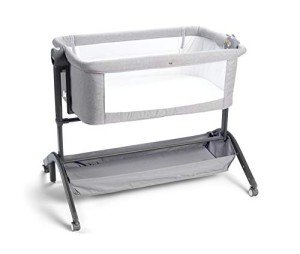
Online Cots
Add a review FollowOverview
-
Founded Date 25 May 1913
-
Sectors Health Care
-
Posted Jobs 0
-
Viewed 54
Company Description
Are You Responsible For The Baby Cots Budget? 10 Fascinating Ways To Spend Your Money
The Essential Guide to Baby Cots in the UK
Picking the ideal cot for a newborn can be an overwhelming job for new parents. With numerous choices offered in the UK market, comprehending the functions, safety standards, and kinds of baby cots is important. This post intends to supply an informative introduction of the different baby cots offered, their advantages, toddler sleep patterns and considerations for moms and dads in the UK.

Kinds Of Baby Cots
There are numerous types of baby cots offered in the UK, each developed to satisfy different needs and preferences. The most typical types consist of:

-
Standard Cots: These are traditional baby cots that offer a safe sleeping environment for babies and babies. They normally feature adjustable mattress heights to suit the baby’s development.
-
Convertible Cots: Also called 3-in-1 or 4-in-1 cots, these flexible options can change from a cot to a young child bed and even into a full-size bed. They are created for extended usage, making them a cost-efficient choice.
-
Moses Baskets: Ideal for the early months, Moses baskets are light-weight and portable, making them easy to move around the home. They usually feature a removable cover and a soft mattress.
-
Travel Cots: These cots are collapsible and compact, specifically designed for parents on the go. They feature a luggage for simple transport and are best for slumber parties or vacation trips.
-
Co-Sleepers: These cots are developed to attach to the parent’s bed, permitting simple access to the baby during the night while making sure the child has their own safe sleeping space.
Table 1: Comparison of Baby Cot Types
| Kind of Cot | Age Range | Portability | Longevity | Cost Range |
|---|---|---|---|---|
| Requirement Cot | Birth to 2 years | Low | Moderate | ₤ 120 – ₤ 300 |
| Convertible Cot | Birth to 5+ years | Moderate | High | ₤ 150 – ₤ 500 |
| Moses Basket | Birth to 6 months | High | Low | ₤ 40 – ₤ 150 |
| Travel Cot | Birth to 3 years | Extremely High | Low | ₤ 50 – ₤ 200 |
| Co-Sleeper | Birth to 6 months | Moderate | Low | ₤ 100 – ₤ 300 |
Safety Standards for Baby Cots in the UK
Making sure the safety of a baby cot is paramount. In the UK, all cots must abide by particular guidelines to guarantee they are safe for usage. The following requirements must be fulfilled:
-
British Standard BS EN 716: This basic sets requirements for the security and performance of children’s cots and folding cots.
-
Product Safety: The cot ought to be made from non-toxic materials that are devoid of hazardous chemicals.
-
No Sharp Edges: Ensure there are no sharp edges or protruding points that might damage the baby.
-
Stable Structure: The cot needs to have a steady base to avoid tipping, and the slats need to be spaced correctly to prevent the baby’s head from getting trapped.
-
Mattress Fit: The mattress ought to fit comfortably in the cot, without any gaps that could pose a suffocation danger.
Functions to Consider When Choosing a Baby Cot
When selecting a baby cot, parents need to keep the following features in mind:
-
Adjustable Mattress Heights: Cots with adjustable heights make it simpler to put and lift the baby as they grow.
-
Material Quality: Look for sustainably sourced wood or materials that are both durable and safe for children.
-
Relieve of Assembly: Cots that are simple to assemble and take apart can save parents time and aggravation.
-
Storage Options: Some cots feature built-in storage drawers to keep baby fundamentals organized.
-
Style and Aesthetic: Choose a cot style that fits well with the home decoration while ensuring it is functional and safe.
FAQs About Baby Cots in the UK
Q1: How much should I anticipate to invest in a baby cot?
A1: Prices for baby cots in the UK can vary extensively based upon type and brand name, ranging from ₤ 40 for a basic Moses basket to over ₤ 500 for high-end convertible cots.
Q2: When can my baby transfer to a cot from a crib?
A2: Most children shift to a cot between 6 months and 2 years, depending upon their size and movement. It’s important to monitor their developmental milestones.
Q3: Are pre-owned cots safe to use?
A3: While pre-owned cots can be safe, guarantee they fulfill current safety standards and show no signs of wear, damage, or recalls. It’s a good idea to avoid older designs that may not adhere to current policies.
Q4: Can I use a cot for a co-sleeping plan?
A4: Co-sleeper cots are created specifically for this purpose, permitting you to keep your baby close while maintaining a safe sleeping environment. Constantly comply with co-sleeping safety recommendations.
Q5: What is the very best bed mattress type for a baby cot?
A5: A company and flat bed mattress is suggested for babies. Avoid soft bed mattress, as they increase the threat of suffocation. Guarantee it fits snugly in the cot without any gaps.
Selecting the ideal baby cot is an essential decision for new parents in the UK. It needs cautious consideration of security guidelines, types of cots offered, and includes that accommodate their specific requirements. By being knowledgeable, moms and dads can create a safe and comfortable sleeping environment for their newborns, making sure peace of mind throughout those important early months. Ultimately, investing time in research study can result in a notified choice that balances security, comfort, and practicality.


